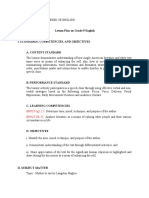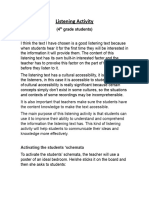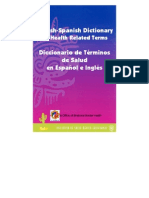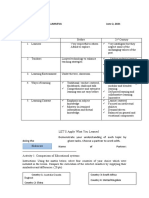Presentación (Young Learners - 2014
Presentación (Young Learners - 2014
Uploaded by
SometingCopyright:
Available Formats
Presentación (Young Learners - 2014
Presentación (Young Learners - 2014
Uploaded by
SometingOriginal Title
Copyright
Available Formats
Share this document
Did you find this document useful?
Is this content inappropriate?
Copyright:
Available Formats
Presentación (Young Learners - 2014
Presentación (Young Learners - 2014
Uploaded by
SometingCopyright:
Available Formats
ORAL WORK
1.Carlos Valiente
2.Exon Cabeza
3.Armando Villa
4.Ernesto Serge
Speaking
General comments
Limitations: It`s complex.
Mother tongue: Children make fun of language.
Their unspoken Assumptions: Lack of actual language.
We dont know what children want to say: Children will
use their native language (communication)
Finding the balance: Controlled & Guided activities
(natural talk)
Correction: It should be done straightforward,
(imitation).
For free oral activities the emphasis for the pupil
should be on content, so correction should not be
done while the activity is going on.
Presenting new language
orally
Presentation ------- Oral production.
Through the pupils: (actions and sounds)
Using a mascot (puppets):
Its successful, familiar and
(good for questions).
Examples: (A model) Teddy.
Drawings:
Theyre social, psychological, encourages
creativity, and imagination,
Silhouettes: Overhead projector,
can be attached to a piece of wire.
Masks
They should be easy (paper)
Mime, act situations, use realia such as clothes,
telephones, etc.
Puppets:
Controlled practice
As well as presentations, controlled practice is
good for the pupils to learn and review
vocabulary. Two examples of this are activities
like:
Telling the time
Whats she doing?
Guided Practice
This type of activities follows on directly from
controlled practice and will often be done
ether in pairs or in small groups.
Whats the time? : Same activity as in the
controlled one, but more extended.
Chain work: use flashcards to make sentences
with the pictures seen on them.
Dialogues and
Role Play Work
Working with dialogues is a useful way to
bridge the gap between guided practice and
freer activities controlled dialogues can easly
develope into freer work when the pupils are
ready for it.
Using objects:
Examples
Role play: Another way of presenting
dialogues is through role play. In this type of
activities, pupils are pretending to be someone
else.
Examples:
Student A is a custumer that needs something
from a store. Student B is the clerck of the store.
Make a conversation.
Free Activities
CHARACTERISTICS
Focus on message/content.
Genuine communication.
Show that learners can/cant use English.
Focus on meaning. Fluency over accuracy.
(Mistakes corrected afterwards.)
Minimal teacher control (Check students have enough language to do task.)
Informal and non-competitive atmosphere. (Everyone wins!)
Game element often present.
Wide range of free activities card games, mini-talks, personal or school news.
Pair Work
ACTIVITIES: Mostly based on the information gap principle.
Classroom arrangement Half of the class turns their backs to teacher. He/she
gives info to those facing him/her. Then, they pass it on to the other students.
1. Older children One student receives map A and the other gets map B.
St A explains to st B where the places
are, or St. B asks where they are.
Restricted free exercise Vocabulary
and language structures are limited.
Learners should know where to start.
Pair Work
2. Younger Children A more communicative activity. Teacher gives all students a
a picture to color. Two groups As color the girl, and Bs color the boy. Teacher walks
around interacting with sts. Then, teacher
puts As and Bs facing and asking each
other how they have colored their part of
the picture: What color is his shirt/her
blouse? Teacher makes sure As and Bs
dont see each others pictures. Pictures
should be identical in the end!! Learners decide what colors to use!!
Pair Work
2. Find the differences
Group Work
EXAMPLES: These are easy to organize, fun, and
focused on oral work. Teacher plays a non-dominant
role. Just a facilitator or organizer.
1. Teacher takes a picture story, copies it, cuts
it up and gives one picture to each member of
the group. Then, each student describes to the
others what is in his/her picture without
showing it to the others. Finally, the group decides on
the correct order of the pictures.
Group Work
2. Story-telling (More imaginative, suitable for the 8/10-year-olds)
Everyone in the group has two objects or pictures, to be woven into a story.
Teacher starts off the story: I went
to the beach with my family last week.
The story continues with a student
according to the objects/pictures they
have. For example: (car: We went in my new car.// weather
The weather was awful.). As the story goes on with a different
student, it gets funnier and more ridiculous, and students have
to help each other to make it to the end.
Whole Class Activities
(Matching Activity)
NAME MONDAY TUESDAY WEDNESDAY THURSDAY FRIDAY SATURDAY SUNDAY
Marta
Prez
Take an
English class.
Go to work.
Questionnaire
Ask your partners questions about what they do each
day of the week. Use the following questionnaire if the
answer is no, ask then, when they do those activities.
1. Do you go shopping on Mondays?
2. Do you do the laundry on Saturdays?
3. Do you take an English class on Sundays?
4. Do you clean the house on Wednesday?
5. Do you do the ironing on Tuesdays?
6. Do you eat out on Fridays?
7. Do you get up late on Thursdays?
8. Do you make a lot of phone calls on Mondays?
9. Do you exercise on Fridays?
10. Do you have lunch at home on Saturdays?
11. Do you make your own breakfast on Sundays?
12. Do you watch TV on Wednesday?
13. Do you have breakfast at home on Tuesdays?
14. Do you read the newspaper on Thursdays?
Example: A)Do you play videogames on Mondays?
B) No, I don`t.
A) When do you play video games?
B) I play videogames on Sundays.
THANKS!
Micro-Teaching Class
Objectives: Sts. will be able to express some animal
movements in English. (8-10 years old)
Warm-up: (TPR) Ask the children to stand in a
circlethey will do what do teacher does in a fun way.
Example: jump, swim, climb, or Im jumping,
swimming, etc. (5 min)
Presentation: Present the language through
flashcards.
Practice: Choose one child to select an animal, eg. A fish.
Ask him/herWhat can your animal do?, eg. Swim.
Write on the boardIm a fish and I can swim
Ask the child to read this sentences aloud. This child then selects
someone else to choose another animal.
The next child chooses an animal and says, He is a fish and he
can swim. I am a monkey and I can climb.
This can continue for as long as the children can remember the
animals learned in class.
Homework: Students have to write about 3 different animal
movements.
You might also like
- Fluentzy by Kev NairDocument20 pagesFluentzy by Kev NairSharanu Melmalgi100% (4)
- EFL To Small ChildrenDocument66 pagesEFL To Small ChildrenIoana100% (5)
- Nice Activities For StudentsDocument5 pagesNice Activities For StudentsSerena GulinoNo ratings yet
- SYLLABUS Physics 102 General Physics For Nursing StudentsDocument4 pagesSYLLABUS Physics 102 General Physics For Nursing StudentsDennis Cosmod100% (3)
- Tema 3.2 InglésDocument6 pagesTema 3.2 InglésLucía Cobo RodríguezNo ratings yet
- 2nd Year Tale For PrimaryDocument12 pages2nd Year Tale For PrimaryBea MsbNo ratings yet
- Role-Play and Simulations - Eva..Document17 pagesRole-Play and Simulations - Eva..Mario LandioNo ratings yet
- MODULE 11 SpeakingDocument32 pagesMODULE 11 SpeakingMajumy Villanueva FulgencioNo ratings yet
- ESP2 (Valdo Varelleo Zulla 1619500066)Document15 pagesESP2 (Valdo Varelleo Zulla 1619500066)Takasu ryuujiNo ratings yet
- Task 3Document3 pagesTask 3api-374751355No ratings yet
- Making Teaching Fun!: Why Using Games?Document9 pagesMaking Teaching Fun!: Why Using Games?Ramona Iuliana NeculaNo ratings yet
- Teaching Resources Websites: Word Focus GamesDocument11 pagesTeaching Resources Websites: Word Focus GamesLADY LYN ANDRINONo ratings yet
- 6classroom Activities ShsDocument48 pages6classroom Activities ShsAri WidiyantoNo ratings yet
- Making Teaching FunDocument10 pagesMaking Teaching FunRamona Iuliana NeculaNo ratings yet
- Crazy Story: Level: Any LevelDocument13 pagesCrazy Story: Level: Any LevelCami Inthesky WithDiamondsNo ratings yet
- 9 TEYL Supplement Activities With Visuals, Realia, and MovementDocument43 pages9 TEYL Supplement Activities With Visuals, Realia, and MovementShela Noviriantika HidayahNo ratings yet
- Module OneDocument17 pagesModule OneHyoun Ji SeoNo ratings yet
- Teacher - S Class Teaching English LectureDocument77 pagesTeacher - S Class Teaching English LectureMohammad Abd Alrahim ShaarNo ratings yet
- Lbs 330 LessonplanDocument11 pagesLbs 330 Lessonplanapi-370979946No ratings yet
- Vacation Unit: By: Natasha Zeng Wheaton CollegeDocument35 pagesVacation Unit: By: Natasha Zeng Wheaton Collegeapi-297825671No ratings yet
- AppendixDocument20 pagesAppendixapi-203628992No ratings yet
- My 1st GRD BK Complete PDFDocument80 pagesMy 1st GRD BK Complete PDFferferitaNo ratings yet
- Key Lesson Elements What Is The Teacher Doing? What Are The Students Doing?Document3 pagesKey Lesson Elements What Is The Teacher Doing? What Are The Students Doing?kelseywheatonNo ratings yet
- Lesson Observation and ReflectionDocument2 pagesLesson Observation and Reflectionapi-172277450No ratings yet
- Reflection Sat 5Document3 pagesReflection Sat 5api-218111808No ratings yet
- Lesson Presentation: Learning Activities Complete The Following Table and Answer The Questions BelowDocument3 pagesLesson Presentation: Learning Activities Complete The Following Table and Answer The Questions Belowapi-294972438No ratings yet
- Lesson Presentation: Learning Activities Complete The Following Table and Answer The Questions BelowDocument3 pagesLesson Presentation: Learning Activities Complete The Following Table and Answer The Questions Belowapi-294972438No ratings yet
- Ict Lesson Plan 1Document5 pagesIct Lesson Plan 1api-281724924No ratings yet
- Day 4Document3 pagesDay 4api-345600102No ratings yet
- Plan de Lec VIIIDocument4 pagesPlan de Lec VIIIAndreia Ghencea DobraNo ratings yet
- Design For Learning Vocabulary 2Document4 pagesDesign For Learning Vocabulary 2api-242798278No ratings yet
- Listening HandoutDocument12 pagesListening HandoutcroatiatamielNo ratings yet
- Puppet Micro Teach Lesson PlanDocument3 pagesPuppet Micro Teach Lesson Planapi-237193640No ratings yet
- Classroom Management Plan 1Document3 pagesClassroom Management Plan 1api-543291605No ratings yet
- Read Aloud Lesson PlanDocument6 pagesRead Aloud Lesson Planapi-437591352No ratings yet
- Topic 4 - Teaching SpeakingDocument25 pagesTopic 4 - Teaching SpeakingMiftahul JannahNo ratings yet
- MC 2nd Term English Week 5 2023-2024Document14 pagesMC 2nd Term English Week 5 2023-2024Vanezzitta PachuchoNo ratings yet
- ObservationDocument2 pagesObservationapi-352507025No ratings yet
- ESL Activities: Reading Writing Speaking ListeningDocument51 pagesESL Activities: Reading Writing Speaking ListeningShelbyyeldenNo ratings yet
- Yan Tefl CoursesDocument13 pagesYan Tefl CoursesPhương LêNo ratings yet
- All For Fun and Fun For AllDocument5 pagesAll For Fun and Fun For AlldharshinishuryaNo ratings yet
- MC 2nd Term English Week 6 2023-2024Document16 pagesMC 2nd Term English Week 6 2023-2024Vanezzitta PachuchoNo ratings yet
- Why It's So Important For Our Students To Stop Translating and Start Thinking in EnglishDocument9 pagesWhy It's So Important For Our Students To Stop Translating and Start Thinking in Englishsabbeena jowkinNo ratings yet
- Unite 2 QuizDocument4 pagesUnite 2 Quiztetianalyt171No ratings yet
- Lesson Plan On Grade 9 English I. Standards, Competencies, and Objectives A. Content StandardDocument13 pagesLesson Plan On Grade 9 English I. Standards, Competencies, and Objectives A. Content StandardCherry Ann Marcial NabascaNo ratings yet
- 14 Engaging ESL Activities For Young LearnersDocument11 pages14 Engaging ESL Activities For Young Learnersmehrdad anzaniNo ratings yet
- The Audiolingual MethodDocument6 pagesThe Audiolingual MethodBalvinder0% (1)
- Day 3Document3 pagesDay 3api-295499894No ratings yet
- Field Observation1 Yovana GarzaDocument11 pagesField Observation1 Yovana Garzaapi-744696193No ratings yet
- Copia de Listening Activity Final ExamDocument10 pagesCopia de Listening Activity Final ExamYael AlvarezNo ratings yet
- Didactic Unit FamilyDocument8 pagesDidactic Unit FamilyIsa GuacamoleNo ratings yet
- Introduction. Background Information SpeakingDocument4 pagesIntroduction. Background Information Speakingjesusadrian2010No ratings yet
- Warm-Up Activities & Lead-In ActivitiesDocument6 pagesWarm-Up Activities & Lead-In ActivitiesHung Thuyen PhamNo ratings yet
- Camp Activities - Grade 6Document23 pagesCamp Activities - Grade 6fathinus21No ratings yet
- Drama10 Orientation Jan14 Educ3601Document4 pagesDrama10 Orientation Jan14 Educ3601api-297038017No ratings yet
- Lesson Plan Seventh Grade Present ContinuousDocument5 pagesLesson Plan Seventh Grade Present Continuousapi-350308752No ratings yet
- Chinese Whispers: - ESL Listening and Speaking ActivitiesDocument5 pagesChinese Whispers: - ESL Listening and Speaking ActivitiesClement JongNo ratings yet
- My School DiaryDocument29 pagesMy School DiaryreinaterNo ratings yet
- Task 4Document2 pagesTask 4api-314739687No ratings yet
- Latrodectus Mactans Black Widow SpiderDocument33 pagesLatrodectus Mactans Black Widow SpiderSometingNo ratings yet
- Velcro The Hook and Loop FastenerDocument8 pagesVelcro The Hook and Loop FastenerSometingNo ratings yet
- DisastersDocument20 pagesDisastersSometingNo ratings yet
- Avoiding RepetitionDocument2 pagesAvoiding RepetitionSometingNo ratings yet
- The EagleDocument13 pagesThe EagleSometingNo ratings yet
- ELT - Planning For SuccessDocument25 pagesELT - Planning For SuccessSometingNo ratings yet
- Critical EssayDocument4 pagesCritical EssaySometingNo ratings yet
- Summary of Curricular Variation in CLILDocument1 pageSummary of Curricular Variation in CLILSometingNo ratings yet
- Self-Evaluation Form For English TachersDocument1 pageSelf-Evaluation Form For English TachersSometingNo ratings yet
- 1 PhoneticsDocument2 pages1 PhoneticsSometingNo ratings yet
- Activity Based ApproachDocument2 pagesActivity Based ApproachSometingNo ratings yet
- Diccionario Medico Ingles EspañolDocument191 pagesDiccionario Medico Ingles EspañolBrussel LasVegas100% (1)
- GG PDFDocument2 pagesGG PDFilovevdkNo ratings yet
- Rentsch 1992Document12 pagesRentsch 1992Andi Putri MaharaniNo ratings yet
- Chapter 1 ReviewerDocument7 pagesChapter 1 ReviewerClariña VirataNo ratings yet
- Induction Policy and Checklist Policy StatementDocument7 pagesInduction Policy and Checklist Policy StatementrjpallaviNo ratings yet
- Perimeter With GeoboardsDocument3 pagesPerimeter With GeoboardssnoopyNo ratings yet
- Morris, R., & Perry, T. (2019)Document19 pagesMorris, R., & Perry, T. (2019)Muhammad Raditya Rizky PratamaNo ratings yet
- Literary Criticism On The Way Up To HeavenDocument8 pagesLiterary Criticism On The Way Up To HeavenKhairunnisa SharomNo ratings yet
- Teacher and The School CurriculumDocument9 pagesTeacher and The School CurriculumAnthony HeartNo ratings yet
- Cover Letter Larissa GormanDocument2 pagesCover Letter Larissa Gormanapi-435764597No ratings yet
- Introduction of Insurance of LICDocument7 pagesIntroduction of Insurance of LICKanishk Gupta100% (1)
- ENGLISH2 Q2wk3 '22Document3 pagesENGLISH2 Q2wk3 '22GEMALYN REFUELONo ratings yet
- The Shri Ram School - Moulsari English: Short Story Class: 7 Name: - Sec: - DateDocument4 pagesThe Shri Ram School - Moulsari English: Short Story Class: 7 Name: - Sec: - DateIshwar Singh SandhuNo ratings yet
- March 2019 (v2) MS - Paper 6 CIE Chemistry IGCSEDocument6 pagesMarch 2019 (v2) MS - Paper 6 CIE Chemistry IGCSEPuja DhawanNo ratings yet
- Module 5 Edteap VillanuevaDocument4 pagesModule 5 Edteap VillanuevaEcho Siason EleccionNo ratings yet
- Representation Skills of Students With Different Ability Levels When Learning Using The LCMR ModelDocument16 pagesRepresentation Skills of Students With Different Ability Levels When Learning Using The LCMR ModelSri HaryatiNo ratings yet
- Intro To ASCP PresentationDocument32 pagesIntro To ASCP PresentationSundar SeetharamNo ratings yet
- B.E. Part-Time 2021finalDocument27 pagesB.E. Part-Time 2021finalVigneshvar BalamuruganNo ratings yet
- Portfolio Assignment Draft 2Document28 pagesPortfolio Assignment Draft 2api-270741508No ratings yet
- Workplace Stress Management InterventionsDocument3 pagesWorkplace Stress Management Interventionsandreea_zgrNo ratings yet
- Management of Libraries and Information Sciences by Naznin BanuDocument12 pagesManagement of Libraries and Information Sciences by Naznin BanuDr. SHIVA AITHALNo ratings yet
- Module 2 EssaysDocument3 pagesModule 2 EssaysTimothy CNo ratings yet
- Daily Lesson Log: I. ObjectivDocument3 pagesDaily Lesson Log: I. ObjectivquezoncollegesofthenorthNo ratings yet
- Module 2Document9 pagesModule 2KeishaAaliyahNo ratings yet
- Lesson Plan 2: RevisedDocument3 pagesLesson Plan 2: RevisedYulia CookNo ratings yet
- Faculty List 2017 18Document13 pagesFaculty List 2017 18Somesh JallelaNo ratings yet
- ANF Anti Narcotics NotesDocument111 pagesANF Anti Narcotics NotesRizwan SaeedNo ratings yet
- 1.1 LRMDS Educational Soundness General Evaluation ChecklistDocument5 pages1.1 LRMDS Educational Soundness General Evaluation ChecklistNiko Igie Albino PujedaNo ratings yet
- Animal Cracker Rolled Throughput YieldDocument6 pagesAnimal Cracker Rolled Throughput YieldJerry Dykyj100% (1)
- Linkages and Networking With OrganizationsDocument25 pagesLinkages and Networking With OrganizationsKristy Dela CernaNo ratings yet






































































































